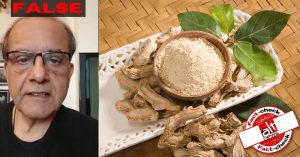On 8th of March 2019, four IIT-Delhi entrepreneurs launched a product called ‘Sanfe Period Pain Relief Roll-On’ that claimed to help with menstrual pain. The start-up group (Redroom Technology Private Limited) who launched the Sanfe claimed to have an FDA approval, after which an Alt News Science investigation reported it as a false claim. This previous press release with the FDA approval was published without any fact-checking by several news outlets such as The Indian Express, NDTV, The Times of India, The Economic Times, and India Today.
After releasing our 1st investigative report on Sanfe, the co-founder of Redroom, Archit Agarwal sent a copy of the corrigendum published in The Hindu on the 28th of March 2019, accepting that it was a mistake to suggest that Sanfe was FDA approved. However, in the corrigendum, Redroom maintained that the approval was actually from the AYUSH ministry instead. On the phone, Archit Agarwal also maintained that the formula was clinically tested before release, and was safe for use.
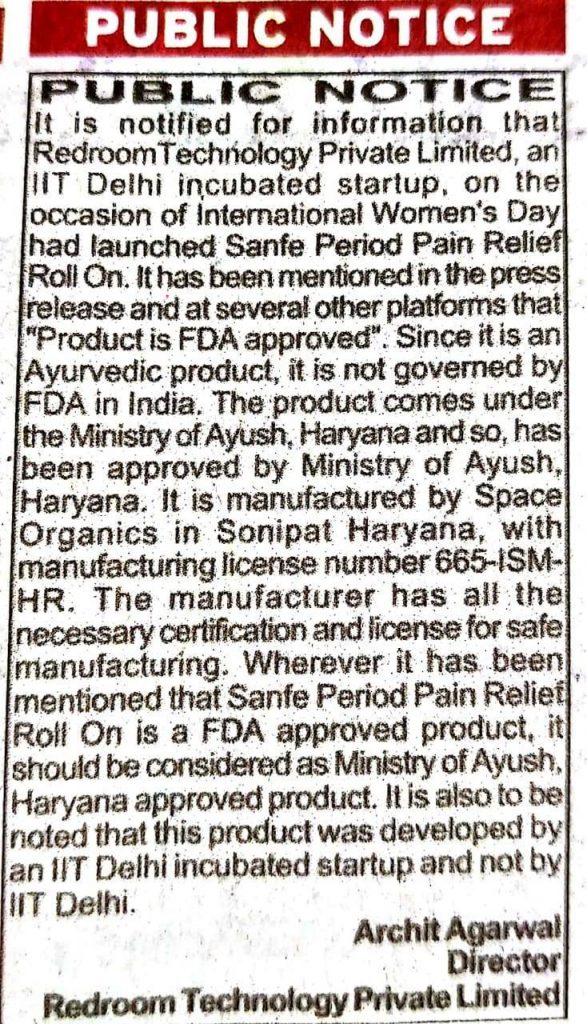
We contacted the AYUSH ministry, Haryana’s Dr Satish Khatkar, who approved the formulation to determine the authenticity of the certificate of approval by AYUSH. Additionally, we conducted a literature review on the research of different components of the Sanfe roll-on to determine whether it was safe and effective to use as per the claim.
Claims:
- Archit Agarwal clarified that the AYUSH certificate means that Sanfe roll-on is approved by AYUSH
- Sanfe, consisting of 100% natural oils, causes no side effects. (as per the packaging)
- It targets the source of pain without having to take ‘pain killers’ (as per the packaging)
Fact Check:
- The claim of approval from AYUSH
- The claim of a safe and natural composition
- The claim of suggesting it as devoid of traditional pain-killers, which target the source of pain.
Both, Redroom Technology and co-founder Archit Agarwal, maintained that the certificate of approval was from the AYUSH ministry, Haryana, and not by the FDA, which was a ’mistake’. When we contacted the authority who had signed this certificate at AYUSH, Dr Satish Khatkar suggested that the document was NOT an approval for safety for the products but only a certificate of approval for manufacturing (see the image of its manufacturing licence).
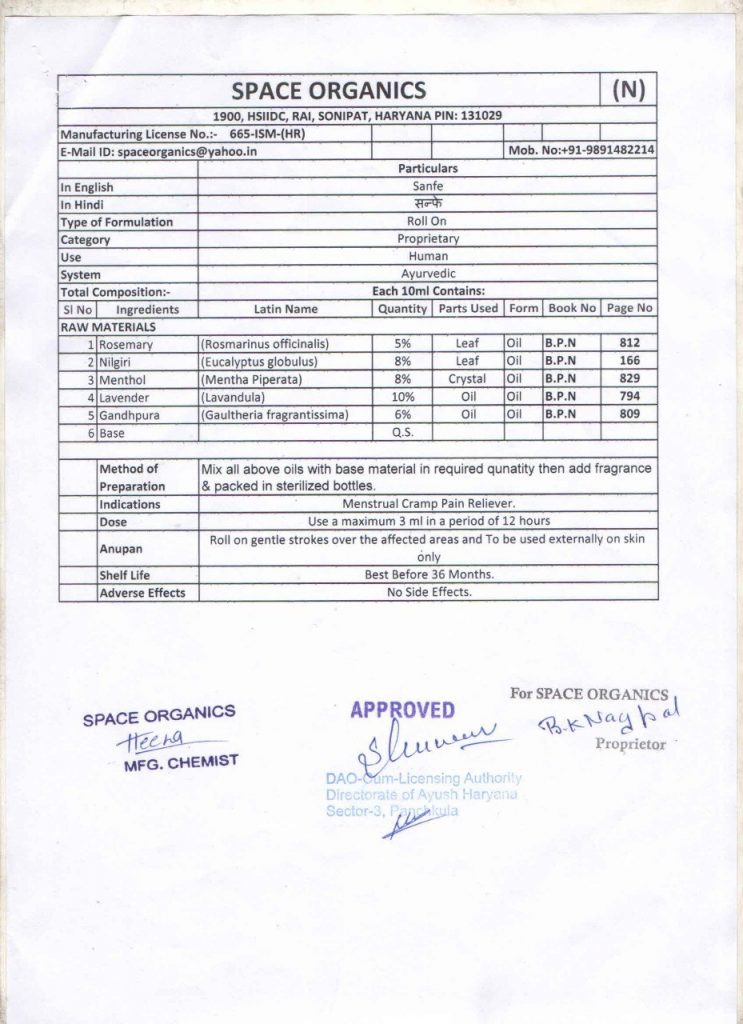
Dr Khatkar from AYUSH, also suggested that the certificate meant those individual components of the product may be effective and safe according to the ancient textbook of Ayurveda, Bhavaprakasha Nighantu (B.P.N), which had not been approved as a combined specific formula that Sanfe roll-on is.
Moreover, the certificate or manufacturing licence is given after a confirmatory test by AYUSH that the product has only the individual components as per the claim of the manufacturer and that no other safety tests are conducted by AYUSH.
Khatkar also suggested that the responsibility of conducting these safety and toxicity tests was upon the manufacturer, in this case, Space Organics, Haryana. In our previous conversation, the owner of Space Organics, Mr Nagpal, had confirmed that it was not financially viable for them to conduct tests for a product that had a higher research cost than its production cost. Hence, no testing was conducted on this product before its release.
After the first Alt News investigative report, Space Organics and Redroom released a document that listed the research on 79 women as per the original claim. This document was not a peer-reviewed published document, did not contain any data, nor it was tested for safety in various conditions. Khatkar suggested that such ‘research’ is likely to be a market survey where a group of women are given the product and later verbally asked to report efficacy. This unsystematic measure of efficacy cannot be considered as clinical research as suggested by the founders of Sanfe.
As suggested above, the safety certificate from AYUSH is only for individual components in the roll-on and not for the formula as a whole. As per AYUSH, this safety certificate was backed by the ancient Ayurvedic text Bhavaprakasha Nighantu (B.P.N).
Any remedy that affects will, evidently, have unwanted side effects. Hence, the dosage is studied to extract the most desired effect with the maximum tolerable adverse effect. It is false to claim that herbal drugs will be completely free of side effects just because they are ‘natural’. Some of the most potent drugs in medicine have been derived from natural substances which also carry the same adverse effects as any other laboratory synthesized compounds.
The use of medicinal plants and oils as a form of topical pain treatment has been widely studied, where detailed adverse effects have been described (Bakkali et al. 2008). Prolonged use of any of the Sanfe’s ‘natural’ ingredients, standalone or in combination, can lead to strong unwanted adverse reactions.
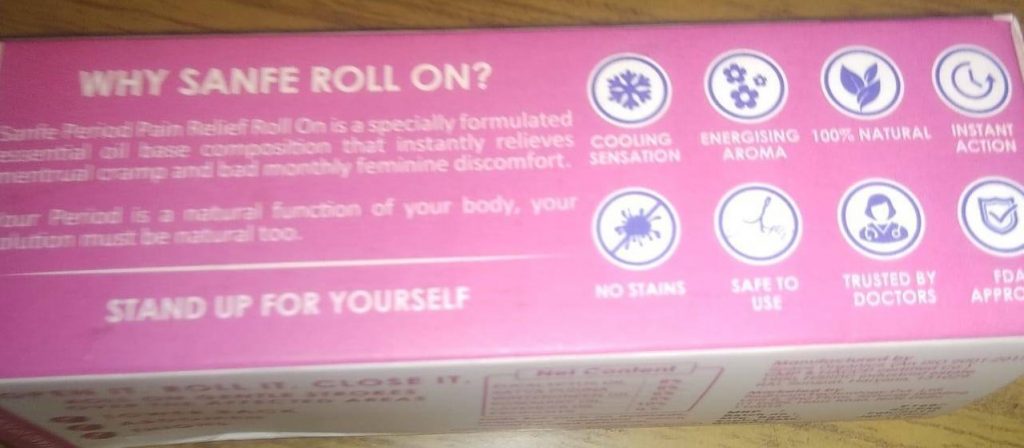
Sanfe roll-on consists of 6 components, and there is no prescribed method to limited the frequency of its use. Apart from the described oils (see the manufacturing licence), reportedly, lavender, gandhipura (wintergreen), nilgiri (eucalyptus), rosemary and base oil, the strongest active ingredient is an extract of the mint in the crystal form. While the packaging shown in the image below doesn’t mention crystalline Menthol (mint) as one of the ingredients, the Space Organics certificate above does. Since mint in the herbal form does not contain high quantities of this active ingredient, a crystalline form of the compound menthol is used which can act on the cold receptors in the skin to give pain relief. This is a low-cost compound synthetically manufactured in the lab and is not safe or natural, if not used correctly.
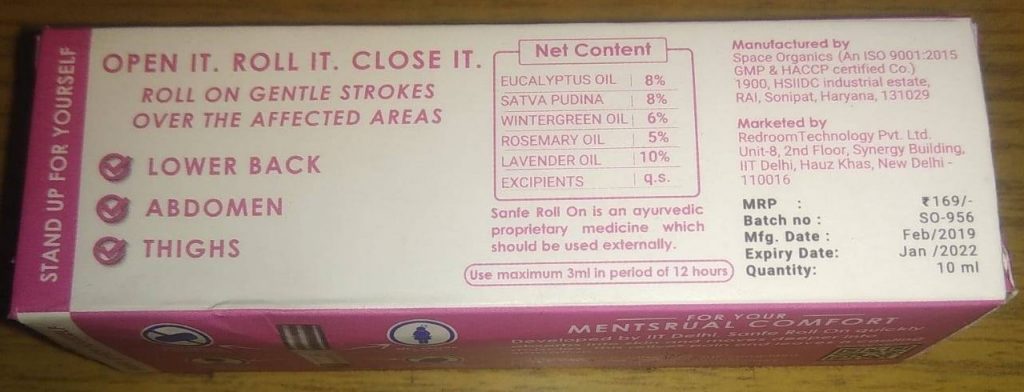
Mint essential oil can contain up to 40-90% menthol which is a potent pain killer acting on the cold receptors in the skin. Several topical anesthetics and nasal decongestants such as Vapour-Rubs also contain menthol.
Additionally, menthol also enhances the penetration of other transdermal drugs, which means that the absorption of other compounds is increased when mixed with menthol. Drug development companies should issue expert advice on consumption of menthol based compounds as it may be toxic and sub-lethal in higher doses starting from 50-500mg per kg of body weight.
The Sanfe formulation contains several ‘pain killer’ compounds in the form of essential oils that is equivalent (in specific dosage) to over the counter pain killers. For example, an American patent describes a mixture of wintergreen oil, olive oil and/or eucalyptus oil as a topical pain killer.
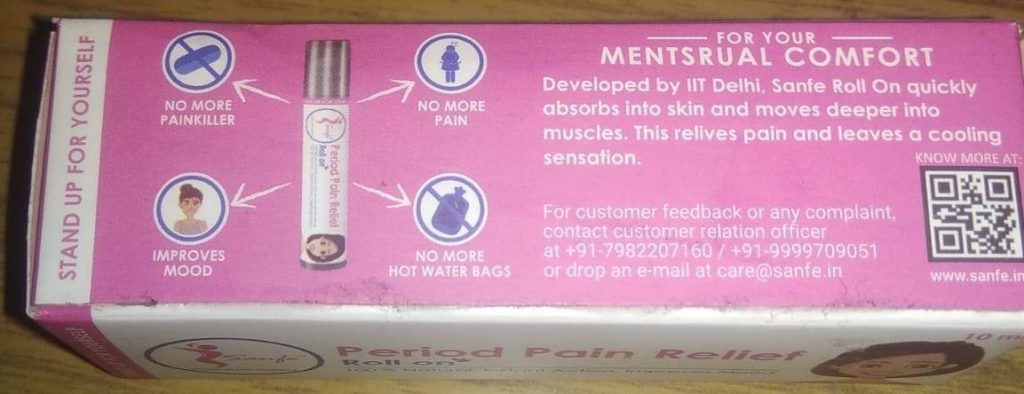
Although Sanfe doesn’t directly claim that its composition has no pain killers, it is contended that pain is reduced without having to take pain killers. Using this roll-on is equivalent to a topical application of consuming a ‘pain killer drug’, provided it gets absorbed into the system in the required dosage.
For example, wintergreen oil (8% in Sanfe roll on) contains about 98% of methyl salicylate, a compound closely related to acetylsalicylic acid, or aspirin- which is a class of ‘pain killers’. Also, if used excessively, wintergreen oil can lead to toxicity from ingestion of methyl salicylate compound. This toxicity varies for different age groups and is the most harmful in small children. For example, 5 ml of methyl salicylate is equivalent to 5 aspirin tablets (325 mg each). Various toxicity studies have confirmed that while low dose skin application was safe or can cause mild-acute irritation to the skin, dosage over 7 gm for a 70 kg adult can result in severe neurological disturbances (Chin et al. 2007).
Other ingredients of Sanfe, such as eucalyptus, lavender, and rosemary have shown limited pain-relieving effects, but have known to cause several skin related, systemic problems and other adverse effects similar to an anaphylactic reaction in higher doses (Darben et al. 1998, Pozadski et al. 2012, Ulbricht et al., 2010). Use of rosemary is also dangerous for anaemics and pregnant women.
Lastly, the claim that it penetrates deep into the source of pain is made without understanding the research in pain mechanisms. Pain during menstruation arises deep within the muscles, while this roll-on is applied only on the skin. The muscle and the skin is separated by several other layers of tissue that do not allow deep penetration of topical drugs unless the drug is in systemic circulation through the bloodstream. Hence, the effect of pain relief with Sanfe may be not be attributed through deep absorption through the skin. This claim shows the developers of Sanfe’s meagre understanding of pain emergence during menstruation.
Conclusion
Hence, once again, the founders of Sanfe, used government institutes such as AYUSH to promote drugs without any background research or understanding of menstrual pain.
Sanfe’s founders also claimed a to have an approval certificate which, through our investigation, turned out to be a manufacturing licence from AYUSH.
The Sanfe formulation is packed with several compounds used as pain-killer medications, as well as other compounds that increase the absorption of such pain-killers, which should be evaluated in toxicity and dosage studies before marketing and administration similar to any other drugs.
Thus, under the Drugs and Cosmetics Act, 1940 and Drugs and Cosmetics Rules 1945, it can be considered as attempts to misbranding the product as defined.
The Ministry of AYUSH in a document lists ethical principles to be followed during a clinical trial for Ayurvedic drugs, the launch of the Sanfe product did not seem to follow those guidelines.
References
Chin, R. L., Olson, K. R., & Dempsey, D. (2007). Salicylate toxicity from ingestion and continued dermal absorption. The California Journal of emergency medicine, 8(1), 23–25.
Bakkali, F., Averbeck, S., Averbeck, D., & Idaomar, M. (2008). Biological effects of essential oils–a review. Food and chemical toxicology, 46(2), 446-475.
De Groot, A. C. and Schmidt, E. (2015), Eucalyptus oil and tea tree oil. Contact Dermatitis, 73: 381-386.
Darben, T., Cominos, B., & Lee, C. T. (1998). Topical eucalyptus oil poisoning. Australasian journal of dermatology, 39(4), 265-267.
Posadzki, P., Alotaibi, A., & Ernst, E. (2012). Adverse effects of aromatherapy: a systematic review of case reports and case series. International Journal of Risk & Safety in Medicine, 24(3), 147-161.
Ulbricht, C., Abrams, T. R., Brigham, A., Ceurvels, J., Clubb, J., Curtiss, W., … & Isaac, R. (2010). An evidence-based systematic review of rosemary (Rosmarinus officinalis) by the Natural Standard Research Collaboration. Journal of dietary supplements, 7(4), 351-413.
Drug and Cosmetics Act 1940 and Drugs and Cosmetic Rules 1945 http://www.cdsco.nic.in/writereaddata/Drugs&CosmeticAct.pdf
http://ayush.gov.in/acts-rules-and-notifications/good-clinical-practice-guidelines-clinical-trials-asu-medicine
Independent journalism that speaks truth to power and is free of corporate and political control is possible only when people start contributing towards the same. Please consider donating towards this endeavour to fight fake news and misinformation.

